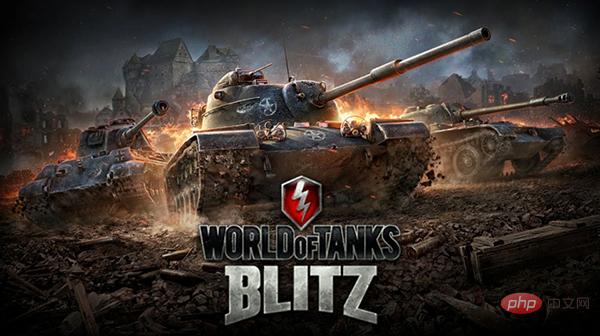 Backend Development
Backend Development
 Python Tutorial
Python Tutorial
 Python is actually used to develop games? Take stock of Python development scenarios you can't think of
Python is actually used to develop games? Take stock of Python development scenarios you can't think of
Python is actually used to develop games? Take stock of Python development scenarios you can't think of

Everyone says that learning Python is good, but what are the benefits? What can Python be used for?
Python has become the new favorite language for software developers when popular services like YouTube, Quora, Pinterest, Facebook, Reddit, Instagram, Google, Netflix, and Spotify started using the language.
In addition to the data science we are familiar with, Python is even now used to develop games. Let’s take a look at the development scenarios in which Python is being used.
1. Data processing
The first is of course the data analysis that we are familiar with. As data continues to grow, the real challenge is making sense of the information. Businesses and organizations are trying to solve this problem by building intelligent systems using concepts and methods from data science, data mining, and machine learning.
When we need machines to make effective data-based decisions, several situations may arise. The following are some scenarios where machine learning is more effective than humans:
- Lack of human experience;
- Dynamic scenarios;
- Transforming expertise into computational tasks.

#In recent years, Python has been increasingly used for data analysis in science and business. The simplicity of the language, as well as the wide variety of open source libraries, allow developers to study any topic and draw conclusions based on the results received.
For example, they used Python to analyze the spread of the coronavirus around the world, sales dynamics on different days of the week, and student performance at different universities. Here are some other examples of data analysis that can be done using Python:
- Sentiment Analysis
- Weather Forecast
- Stock Market Analysis
- Customer Segmentation
- Detect and prevent fraud
- Recommend products to customers
Python can also be effectively used for data visualization, which is an important part of the data scientist's job. Data visualization databases help you display large and complex data sets in a simple and intuitive way.
Matplotlib is a very popular data visualization library written in Python. By using this tool, you can easily build beautiful charts, histograms, bar charts, box plots, and more.
2. Web Development
Python is also very popular in Web development. Python is a very convenient language - it does not compile and looks like plain text before starting. document. Additionally, it requires less code and looks almost like a normal English sentence.
There are many frameworks for web development with Python, some of which not only simplify the development process but also provide tools that allow you to complete a website in a few days. Such frameworks are "full stack" and they also provide many tools including everything needed. For example:
- Django - a high-level framework designed for fast and efficient development. The main principles of Django are DRY and rapid development, encouraging code reuse, such as Instagram, Spotify, etc.;
- Pyramid - This framework is suitable for projects of any size. It has very practical features for creating complex applications or scaling small sites to increase load (Substance-D, Easy Blog Networks);
- TurboGears - an open source for rapid development of data-driven applications Framework (Apache Allura, Kamisons);
- Flask - This is a WSGI framework that can build simple or complex platforms. It is compatible with third-party libraries and has many extensions (Netflix, Lyft);
- Tornado - an asynchronous framework capable of supporting multiple user connections simultaneously. It is ideal for tasks that require a long-lasting connection with each user (Uploadcare).
Of course, these are just the most popular frameworks. There are also frameworks that are more flexible, some that are easier to use, some that are suitable for small projects, and some that are better suited for larger projects. However, all of these simplify the development process and allow you to create projects without having to create database interfaces or issue parse requests.
3. Game script development
Perhaps you can’t imagine that Python is also popular for some large-scale game projects. The following games have been partially developed in this language:
- Civilization 4
- World of Tanks
- The Sims 4
- Battlefield 2
- EVE Online.

How to use Python in the game?
Generally speaking, using Python to develop games is mainly used to write scripts for startup scenes, character interactions, and game events. Some developers have even managed to adapt it into a graphical interface.
Python is often used to prototype programs that are then rewritten in other languages. This is very convenient because creating such a prototype is very fast, and it also helps to understand more clearly how the program works. Python can be used as a prototyping tool for all large projects, but what about the final version?
If your project does not apply machine learning and loading speed is critical, then Python has little use. However, a mixture of different languages, such as Python and C, is often practiced. This approach allows for high development speed and program execution speed. While most of the code is written in Python, C is suitable for those parts that affect execution speed.
4. Mobile App Development
Until recently, there were almost no Android applications using Python. However, many enthusiasts around the world are trying to adapt this one of the best programming languages primarily for web development into the mobile app industry.
While most people prefer using alternatives in mobile development, many applications simply don’t work properly without Python. For example, Instagram, the most popular photo service, is written in Objective-C, but its server part is entirely dominated by Python. Additionally, it is used by Yahoo, Red Hat, Dropbox, Pinterest, Quora, Mail.ru and Yandex.
Over time, developers started developing full-fledged mobile applications in Python. In particular, Python software development for mobile phones is possible thanks to two frameworks - Kivy and BeeWare:
- Kivy is an open source library for developing cross-platform applications. It lets you create Python GUI applications that run on major platforms such as Windows, Android, iOS, and macOS;
- BeeWare provides a set of tools you can use to write mobile and desktop applications.

The key difference between Kivy and BeeWare is that the latter uses platform-specific native UI toolkits and is therefore preferred by many developers.
5. Summary
As we introduced before, Python is one of the five most popular programming languages.
It is widely used in various IT fields such as web development, machine learning, mobile applications, and even game creation. It's easy to learn, has a pleasant syntax, and provides a set of tools sufficient to solve any problem.
Although Python cannot completely replace Java and PHP as the key language for web development, it is still the go-to solution for machine learning.
The above is the detailed content of Python is actually used to develop games? Take stock of Python development scenarios you can't think of. For more information, please follow other related articles on the PHP Chinese website!

Hot AI Tools

Undresser.AI Undress
AI-powered app for creating realistic nude photos

AI Clothes Remover
Online AI tool for removing clothes from photos.

Undress AI Tool
Undress images for free

Clothoff.io
AI clothes remover

AI Hentai Generator
Generate AI Hentai for free.

Hot Article

Hot Tools

Notepad++7.3.1
Easy-to-use and free code editor

SublimeText3 Chinese version
Chinese version, very easy to use

Zend Studio 13.0.1
Powerful PHP integrated development environment

Dreamweaver CS6
Visual web development tools

SublimeText3 Mac version
God-level code editing software (SublimeText3)

Hot Topics
 What is the function of C language sum?
Apr 03, 2025 pm 02:21 PM
What is the function of C language sum?
Apr 03, 2025 pm 02:21 PM
There is no built-in sum function in C language, so it needs to be written by yourself. Sum can be achieved by traversing the array and accumulating elements: Loop version: Sum is calculated using for loop and array length. Pointer version: Use pointers to point to array elements, and efficient summing is achieved through self-increment pointers. Dynamically allocate array version: Dynamically allocate arrays and manage memory yourself, ensuring that allocated memory is freed to prevent memory leaks.
 Is the conversion speed fast when converting XML to PDF on mobile phone?
Apr 02, 2025 pm 10:09 PM
Is the conversion speed fast when converting XML to PDF on mobile phone?
Apr 02, 2025 pm 10:09 PM
The speed of mobile XML to PDF depends on the following factors: the complexity of XML structure. Mobile hardware configuration conversion method (library, algorithm) code quality optimization methods (select efficient libraries, optimize algorithms, cache data, and utilize multi-threading). Overall, there is no absolute answer and it needs to be optimized according to the specific situation.
 How to convert XML files to PDF on your phone?
Apr 02, 2025 pm 10:12 PM
How to convert XML files to PDF on your phone?
Apr 02, 2025 pm 10:12 PM
It is impossible to complete XML to PDF conversion directly on your phone with a single application. It is necessary to use cloud services, which can be achieved through two steps: 1. Convert XML to PDF in the cloud, 2. Access or download the converted PDF file on the mobile phone.
 Is there any mobile app that can convert XML into PDF?
Apr 02, 2025 pm 08:54 PM
Is there any mobile app that can convert XML into PDF?
Apr 02, 2025 pm 08:54 PM
An application that converts XML directly to PDF cannot be found because they are two fundamentally different formats. XML is used to store data, while PDF is used to display documents. To complete the transformation, you can use programming languages and libraries such as Python and ReportLab to parse XML data and generate PDF documents.
 How to convert xml into pictures
Apr 03, 2025 am 07:39 AM
How to convert xml into pictures
Apr 03, 2025 am 07:39 AM
XML can be converted to images by using an XSLT converter or image library. XSLT Converter: Use an XSLT processor and stylesheet to convert XML to images. Image Library: Use libraries such as PIL or ImageMagick to create images from XML data, such as drawing shapes and text.
 How to control the size of XML converted to images?
Apr 02, 2025 pm 07:24 PM
How to control the size of XML converted to images?
Apr 02, 2025 pm 07:24 PM
To generate images through XML, you need to use graph libraries (such as Pillow and JFreeChart) as bridges to generate images based on metadata (size, color) in XML. The key to controlling the size of the image is to adjust the values of the <width> and <height> tags in XML. However, in practical applications, the complexity of XML structure, the fineness of graph drawing, the speed of image generation and memory consumption, and the selection of image formats all have an impact on the generated image size. Therefore, it is necessary to have a deep understanding of XML structure, proficient in the graphics library, and consider factors such as optimization algorithms and image format selection.
 Recommended XML formatting tool
Apr 02, 2025 pm 09:03 PM
Recommended XML formatting tool
Apr 02, 2025 pm 09:03 PM
XML formatting tools can type code according to rules to improve readability and understanding. When selecting a tool, pay attention to customization capabilities, handling of special circumstances, performance and ease of use. Commonly used tool types include online tools, IDE plug-ins, and command-line tools.
 What is the process of converting XML into images?
Apr 02, 2025 pm 08:24 PM
What is the process of converting XML into images?
Apr 02, 2025 pm 08:24 PM
To convert XML images, you need to determine the XML data structure first, then select a suitable graphical library (such as Python's matplotlib) and method, select a visualization strategy based on the data structure, consider the data volume and image format, perform batch processing or use efficient libraries, and finally save it as PNG, JPEG, or SVG according to the needs.





